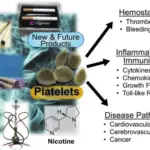Hemophilia B aka Christmas disease is a genetic disorder caused by defective or absent factor IX.
What is the Pathology of Hemophilia B?
The pathology of hemophilia B aka Christmas disease is:
-Etiology: The cause of hemophilia B aka Christmas disease is an inherited or acquired mutation in the factor IX gene, or acquired factor IX inhibitor.
-Genes involved: Factor IX gene.
-Pathogenesis: The sequence of events that lead to hemophilia B aka Christmas disease is factor IX deficiency or dysfunctional factor IX that results in prolonged bleeding.
How does Hemophilia B Present?
Patients with hemophilia B typically are males that present with excessive bleeding at a young age. Other symptoms, features, and clinical findings associated with hemophilia A include easy bruising, hemarthrosis, and epistasis.
How is Hemophilia B Diagnosed?
Hemophilia B is diagnosed with medical history, and clotting factor tests.
How is Hemophilia B Treated?
Hemophilia B aka Christmas disease is treated with a concentrated factor IX product when needed.
What is the Prognosis of Hemophilia B?
The prognosis of hemophilia B aka Christmas disease is good.



